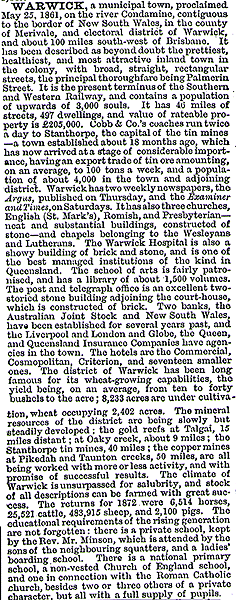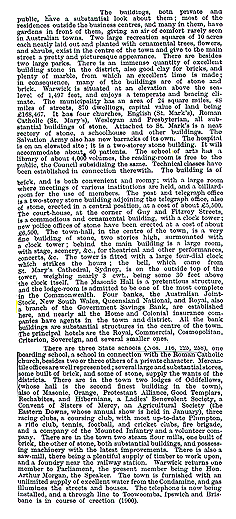Warwick is a town and a separate shire of 4429 sq. km., 162 km. south of Brisbane and 82 km. south of Toowoomba. It is on the Condamine River in the southern Darling Downs. The area was explored by Alan Cunningham in 1827 and first settled in 1840 by a grazier, Patrick Leslie (1815 – 1881). In 1847 Leslie, at the request of the N.S.W. government, selected a sire for a town, which became Warwick. After Brisbane, Warwick was the first town in the future colony of Queensland. Leslie named it after Warwick, near Coventry, England.
The township was proclaimed a municipality in 1861, and one of the first National Schools, Warwick East, was built in 1864. It was still in use in 1995. The 1860s also saw substantial wheat growing in the district, a Cobb and Co. coach service and sheep breeding studs. Warwick’s prominence was described in The Australian Handbook, 1875 –

Warwick was connected by railway to Ipswich in 1871, and its fertile hinterland became well populated. The town’s wide streets were lined with substantial buildings made from the abundant local stone and clay for brickmaking. Well planted parks and recreation squares added to the town’s appearance. There was prosperous mixed farming around Warwick – wheat, grapes and wine-making, potatoes, oats, tobacco, dairying, butter and cheese-making, pigs and bacon curing. These activities were assisted by the subdivision of large pastoral estates, including Patrick Leslie’s famous Canning Downs Estate. The original Leslie house (c. 1846), is on the Register of the National Estate. The town’s enhanced amenities were described in 1904 in The Australian Handbook –

Two Warwick notables were Jackie Howe and Billy Hughes. Howe, born on Canning Downs Station in 1861, blade shore 321 sheep in one day. He was a gun shearer, and his other record with machine shearing stood until 1950. The Jackie Howe blue sleeveless singlet commemorates his fame. Prime Minister Hughes, when speaking on conscription in Warwick until 1917 and was hit by an egg. A police constable denied that he had power to arrest the assailant, provoking Hughes to establish the Commonwealth Police.
From 1861 to 1994 Warwick was an urban municipality. In 1935 it was made a City. Its position in the southern Darling Downs made it suitable as a place for boarding schools. In 1949 there were five private boarding schools, all taking boarders. Its civic festivals included an agricultural show, two race meetings a year and a Scots carnival on Boxing Day. In the 1990s the most prominent event is the Rose and Rodeo Festival. The climate is good for rose-growing, and the festival extends over most of October.
As well as schools, Warwick has a substantial shopping centre of about 150 shops, including the free-standing Rose City Shopping Centre. Woolworths also has a large national distribution warehouse in Warwick. The dairying hinterland supports the Dariyfields cheese factory.
In 1994 Warwick City was amalgamated with the Allora, Glengallan and Mulgrave Shires to form Warwick Shire.
Warwick’s census populations have been 5,248 (1911), 6,664 (1933), 9,303 (1971) and about 11,000 in 1994. Warwick shire’s population in 1994 was 20,600.

Postcard dated December, 1913.
Further Reading:
- Hall, Thomas, The Early History of Warwick District and Pioneers of the Darling Downs, Toowoomba, 192?




Jackie Howe jnr gun shearer was not born at Canning Downs. He was born in Killarney in 1861. His mother had a former husband William Chadbourne and he died in 1864 by drowning in the Condamine while going to register the birth of William Chadbourne Jnr his second child with Annie Chadbourn (nee Stokes). After his death, Annie met Jack Howe Snr in Warwick and he was a circus performer who went on to become Warwicks first “Town Crier”
Jackie Howe jnr gun shearer was not born at Canning Downs. He was born in Killarney in 1861. His mother had a former husband William Chadbourne and he died in 1864 by drowning in the Condamine River while going to register the birth of William Chadbourne Jnr his second child with Annie Chadbourne (nee Stokes). After his death, Annie met Jack Howe Snr in Warwick and he was a circus performer who went on to become Warwick’s first “Town Crier”
The date of William Chadburn’s drowning death in the Condamine River registering the birth of his son William is also eronious. The correct date is 1854.
Louisa Chadburn(e) then widowed remarried John Robert Howe on 23 January 1860 at Killarney.
Well Said Mary Ellen Peters